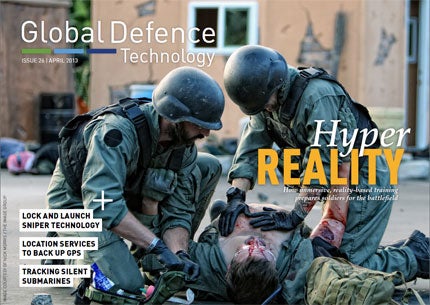
‘Hyper-realistic’ training takes military learning to the battlefield using actors, explosions and combat wound effects. We ask reality-based training experts how this method fits into the military training landscape.
We also take a look at Aeros’ prototype cargo airship for the US military, profile new technologies aiming to ensure snipers stay on target every time they pull the trigger, and explore the LocataNet positioning system which promises accurate location even when GPS is jammed.
Moreover, we profile new unmanned vessel designs for long-duration tracking of enemy submarines, and take a look behind the speculation surrounding the development of a new fast attack craft fleet in Iran.
To read your free copy of this issue, click here.
In this issue
Special Report:
Total Immersion
Hyper-realistic training takes the classroom to the frontline using actors, explosions and combat wound effects. The Halo Corporation’s president Brad Barker and its training partner Strategic Operations executive vice president Kit Lavell discuss how the approach fits into the military training landscape.
Click here to read the full article.
How well do you really know your competitors?
Access the most comprehensive Company Profiles on the market, powered by GlobalData. Save hours of research. Gain competitive edge.

Thank you!
Your download email will arrive shortly
Not ready to buy yet? Download a free sample
We are confident about the unique quality of our Company Profiles. However, we want you to make the most beneficial decision for your business, so we offer a free sample that you can download by submitting the below form
By GlobalDataArmy:
Aeroscraft Vertical Cargo Blimp
Aeros has constructed a prototype cargo airship for the US military that could deliver heavy loads to regions inaccessible by traditional winged logistics aircraft. Global Defence Technology investigates its design and capabilities.
Click here to read the full article.
Zeroing In
Highly disciplined and highly revered, the sniper is celebrated within modern armed forces. Could a new technology that simplifies the art of the "lock-and-launch" procedure make the military marksmen club open to everyone?
Click here to read the full article.
Air Force:
Filling the Gaps
Despite mass investment, GPS still encounters problems. Locata, the company behind the revolutionary reference truth positioning system LocataNet, explains how their solution could be the answer to the US Department of Defense’s woes.
Click here to read the full article.
Navy:
Stalking Silent Submarines
Science Applications International Corporation (SAIC) has unveiled its vision to develop an unmanned vessel for long-duration tracking of even the quietest enemy submarines.
Click here to read the full article.
Fast Attack
Iran’s purchase of the British made Bladerunner speedboat stirred up chatter on the development of a new Iranian navy fast attack fleet. Global Defence Technology examines the developments in Iran’s naval arsenal.
Click here to read the full article.
Next issue preview
Next month we investigate the potential implications of the UK’s Biological Non-Proliferation Programme, which supports research into biological agents that could potentially be used as weapons of mass destruction. We also take a look at the UK’s largest virtual soldier simulation exercise, and explore the use of performance enhancing drugs in the military.
Moreover, we explore the renewed enthusiasm for high-altitude, long-endurance UAVs and promising new designs, take a look at the Royal Navy’s hydrographic capabilities and how the data collected is used. Finally, we ask if the emergence of new Arctic sea routes will create new roles for the world’s navies.
Subscribe for free to receive future issues of Global Defence Technology.
Digital magazine FAQ
The digital magazine is viewable on any computer with Flash Player installed. It is also viewable on mobile devices, iPhones and iPads though some features and videos will be disabled.
View the archive of past issues.




